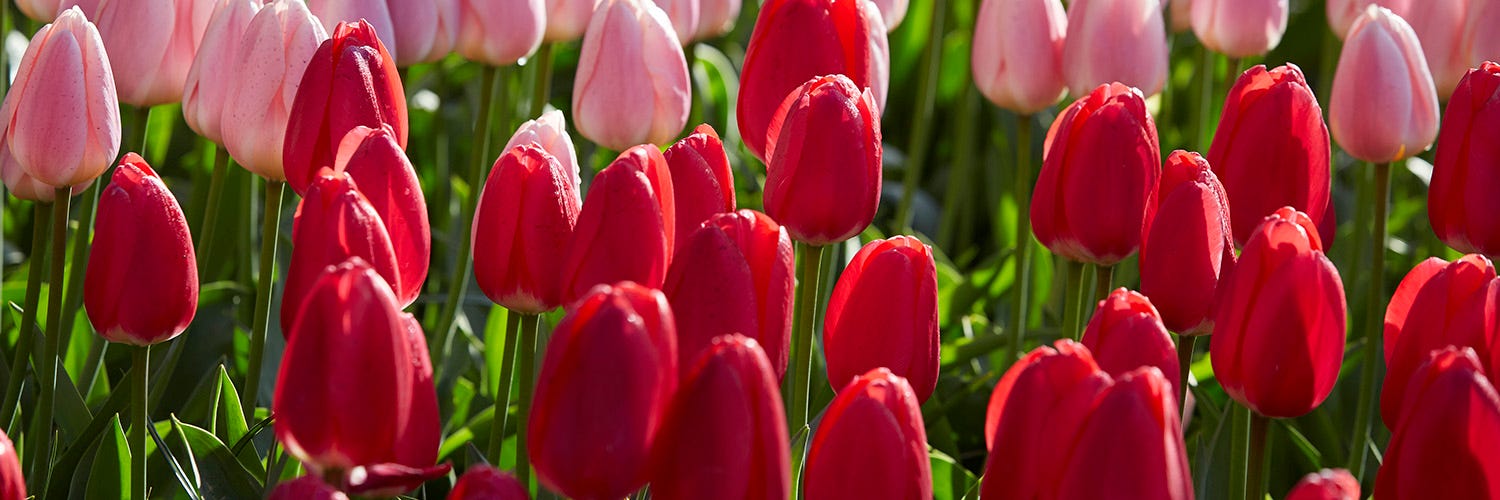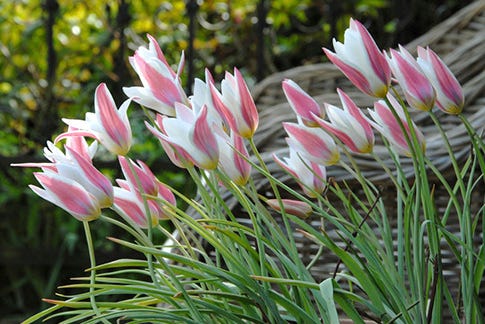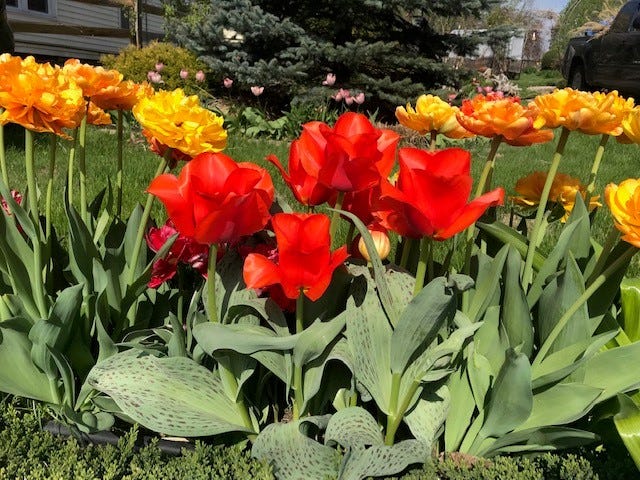By Katrina Godshalk
Simple, elegant, and endlessly variable, Tulips are staples of spring wherever they grow. Here are some guidelines to help you with choosing, planting, and growing Tulip bulbs. Tulips are planted in the fall for a beautiful display of spring blooms. Be sure to choose a selection of bloom times, including early-spring, mid-spring, and late-spring to keep you in flowers all season long.
How To Choose: Annual and Perennial Tulip Varieties
Officially, Tulips are perennial plants. Originating in the steppes of Central Asia, they evolved at altitude in harsh winters and dry summers. Through hybridizing and the difficulties of matching the original Himalayan climate, the tendency of many tulips to perennialize has diminished.
However, at High Country Gardens, we offer Tulip selections with the strongest perennial features. We carry mostly Darwin Tulips, Emperor Tulips, and perennial Wildflower Tulips, known for the ability to return for years to come, and to spread and naturalize. Triumph Tulips and Tulipa greigii may also return for more than one season. For gardeners looking for those classic bright blooms, we also carry annual tulips that will generally not return for a second season.
- Darwin Tulips are reliably perennial for up to 3 years (sometimes longer). They are garden stars, with large flowers on sturdy stems.
- Wildflower Tulips, sometimes called Specie Tulips and Candlestick Tulips, naturalize well. They come back year after year and spread to form colonies of color. They are short, just 4-6 inches tall, but the small flowers open wide to form a carpet of color. They make a great spring border in a perennial bed.
- Emperor Tulips are known for their bright colors, pointed petals, and for their ability to naturalize and return year after year.
- Annual Tulips work well for areas that need a splash of color and variety, and are best for areas where you are not looking to make a long-term investment.
The Wonderful World Of Wildflower Tulips
We carry a wide variety of wildflower tulips. These smaller growers will amaze you with their huge flowers in many extravagant colors. They are strong naturalizers (meaning they increase in numbers during each growing season by propagating more bulbs) and are an essential source of early-season nectar and pollen for hungry honey and native bees. Learn more in our guide: The Wonderful Wildflower Tulips
Tips For Growing Tulips
- Tulips like 6-8 hours of sun per day, so be sure to pick a suitably sunny spot.
- Ideal for a water thrifty garden, tulips don’t need to be watered in the summer!
- Most tulips grow well in zones 3-7, although there are exceptions depending upon the type you are planting. In zones 8 and warmer, bulbs need to be pre-chilled in your refrigerator for 10-14 weeks.
- Mulch in the winter if needed.
How To Plant Tulips
- Tulip bulbs of all types prefer a compost-enriched garden loam with good drainage.
- Dig the soil a few inches below the planting depth to encourage good root growth.
- When planting, have a bucket of Yum Yum Mix (or equivalent), compost, and good garden soil if needed.
- Plant bulbs 6-8 weeks before frost in the fall, or when the soil temperature is below 60 degrees.
- Plant Darwin Tulips or other large bulb tulips at a depth of 8 inches, Wildflower Tulips at 4 inches (follow planting instructions on your bulb package).
- Space large bulbs about 6 inches apart, wildflower bulbs at 7-9 per square foot.
For more planting ideas, learn more in our guides:
Naturalizing Tulips
- To get a natural look, prepare your planting area to the depth needed with spacing allowance.
- Scatter the bulbs in the area and plant them as they fall. This will give you a lovely, natural look.
- Place the pointy end up and cover them with your enriched soil. Water well to encourage good root growth.
- If you live in an area with dry winters you’ll need to water occasionally, otherwise rest assured your bulbs are growing roots in preparation for spring blooms.
Caring For Tulips In The Spring
In the spring, when blooms have faded, cut the flower stems back. Let the foliage age to yellow before removing, as this is how the bulb feeds itself. They are the ultimate xeric bulb, so no extra watering needed for the summer.
Whether you enjoy tulips as cut flowers, or as elegant harbingers of spring in the garden, waiting for their arrival at winter’s end is one life’s sweetest pleasures.
Did You Know?
In Europe, in the 1630s, “tulip-mania” swept Holland. One bulb of Tulip Semper Augustus was sold for 10,000 guilders, an amount that could have bought a grand home on the canal and was ten times the yearly income of a craftsman. The madness over tulip bulb contracts and the subsequent crash in prices almost brought the Dutch economy to ruin.
Shop Tulip Bulbs
© All articles are copyrighted by High Country Gardens. Republishing an entire High Country Gardens article or blog post is prohibited without written permission. Please feel free to share a short excerpt with a link back to the article on social media websites, such as Facebook and Pinterest.


